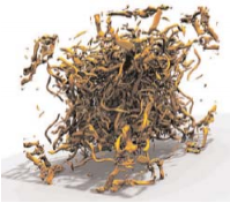When Atoms Collide
RESEARCH CREATES BETTER MODELS FOR SIMULATING SUPERHEATED PLASMAS FOR FUSION ENERGY
May 1, 2007

The streamlines in the image illustrate the velocity distribution of the particles as they move along the lattice links, demonstrating the effectiveness of the lattice-Boltzmann method to model fluid dynamics.
Harnessing fusion power as an endless source of low-cost energy has been an intriguing challenge for scientists. Just ask George Vahala, who has relied on the computing power at NERSC to help other scientists understand the dynamics of generating fusion energy.
Vahala, a physics professor at the College of William and Mary, has been one of the most active users of NERSC resources this year. He has spent most of the 1.18 million computing hours on tackling tricky problems for modeling the flow of hot plasma inside a magnetic chamber as the atoms collide and fuse, a leading approach for generating megawatts of power in a few seconds. For years, Vahala has worked on improving the lattice-Boltzmann method, a relatively new approach to simulating fluid flow that is ideally parallelized and scales almost perfectly with the number of processors available. By embedding the fluid dynamics into a higher dimensional kinetic space, the solution trajectories are easier and more efficiently solved. The trick is to reduce the required memory and to ensure numerical stability at very low transport coefficients.
Over the years, Vahala and his team have made tremendous progress in solving one of the toughest problems: how to ensure the stability of a lattice-Boltzmann code when a high Reynolds number is used to better quantify turbulence? His work also has made it possible for the leap from two-dimensional to three- dimensional modeling using lattice- Boltzmann methods. While the initial runs were performed on the latest Department of Defense machines (an IBM-P5), it was absolutely necessary to turn to the old work-horse, NERSC’s Seaborg machine (an IBM-P3), to complete the simulation runs in 48- hours bursts on 4096 processors.
“Seaborg may be viewed as slow nowadays – but its many processors and large memory made it utterly indispensable for our research,” Vahala said. In many instances, the method has proven to work better than other computational fluid dynamic codes in modeling systems with complex physical geometries. In fact, researchers have used lat- tice-Boltzmann to study a wide range of phenomena, from star formation to the dynamics of cell proteins. In the commer- cial sector, oil companies have turned to the lattice-Boltzmann method for figuring out how to extract more black gold out of the field.
For the past seven years, lattice- Boltzmann has been used to characterize magnetohydrodynamics, the effects of a strong magnetic field on the turbulent flow of electrically conducting fluids such as plasmas. Moreover, the algorithm automatically permits the divergence of the magnetic field to be zero to machine accuracy. Understanding magnetohydro- dynamics, in turn, will help researchers design better tokamaks, the machines that create the magnetic field. In 2005, he co-authored a paper showing how well his three-dimensional lattice- Boltzmann code scaled on the Earth Simulator. The code achieved a sustained 26.25 teraflop/s, registering the best performance by a scientific code on that supercomputer. Jonathan Carter from NERSC was the paper’s lead author while Lenny Oliker from Berkeley Lab’s Computational Research Division was one of the co-authors. The research was published in the Proceedings of SC05.
Vahala’s other recent publications include “Entropic Lattice Boltzmann Representation Required to Recover Navier-Stokes Flows”, Physical Review, E75, 036712::1-11 (2007), “The Lattice Boltzmann Representataion for Plasma Physics” in Physica A362, 48-56 (2006) and “Quantum Lattice Representation for Vector Solutions in an External Potential” in Physica A362, 215-221 (2006).
Aside from Carter, Vahala’s current research team includes Jeffrey Yepez (Hanscom Air Force Base), Linda Vahala (Old Dominican University) and Min Soe (Rogers State University).
About NERSC and Berkeley Lab
The National Energy Research Scientific Computing Center (NERSC) is a U.S. Department of Energy Office of Science User Facility that serves as the primary high performance computing center for scientific research sponsored by the Office of Science. Located at Lawrence Berkeley National Laboratory, NERSC serves almost 10,000 scientists at national laboratories and universities researching a wide range of problems in climate, fusion energy, materials science, physics, chemistry, computational biology, and other disciplines. Berkeley Lab is a DOE national laboratory located in Berkeley, California. It conducts unclassified scientific research and is managed by the University of California for the U.S. Department of Energy. »Learn more about computing sciences at Berkeley Lab.







